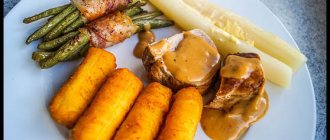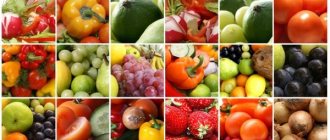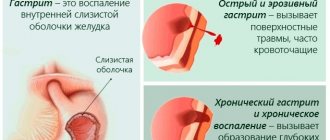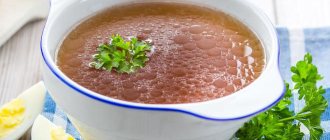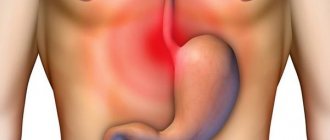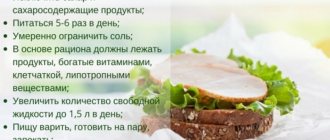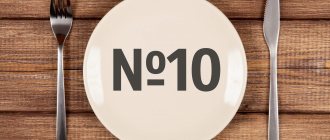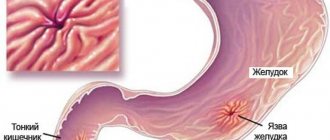What to avoid
Nutrition for gastritis depends on whether it is acute or chronic, and on the level of acidity of the patient’s gastric juice, but for all cases there are general rules:
- No dry food or rush. Poorly chewed food damages the gastric mucosa.
- If you have gastritis, you need to eat 5 times a day in small portions. You should not overeat, especially while drinking alcohol at night.
- Consume only fresh foods. If some food seems questionable to you, it is better to refuse it.
- Food and drink should be warm.
- Food should be prepared for no more than 1-2 days.
The total weight of products per day should not exceed 3 kg, calorie content - 2800-3000 calories.
List of foods for gastritis that must be completely excluded from the diet:
- fried, spicy foods;
- smoked meats; fat meat;
- fatty fish;
- ice cream;
- spices;
- carbonated drinks.
The most important thing that you need to exclude from your lifestyle if you have gastritis is alcohol and smoking.
Contraindications for gastritis include beer, kvass, and wine. You need to be careful when drinking coffee. Dishes for gastritis are prepared with a minimum amount of salt, since it can irritate the mucous membranes. The amount of sweets should also be limited.
The diet for gastritis must include soups. Especially useful is puree soup prepared with vegetable broth and is a source of vitamins. Soups for gastritis should be eaten every day for lunch or dinner.
Contraindications in treatments
Gastritis sometimes develops against the background of prolonged and too intensive use of any pills. Try to treat other ailments using the most gentle means possible.
The so-called NSAIDs—nonsteroidal anti-inflammatory drugs—have a sharply negative effect on the mucous membrane. These include many painkillers (diclofenac, ibuprofen, etc.).
Digestive problems are very likely with unsystematic use of antibiotics. Antibiotics disrupt the intestinal microflora, which affects the functioning of the gastrointestinal tract as a whole.
Why is chronic gastritis dangerous?
The chronic form of gastritis can transform into peptic ulcers and stomach cancer. Therefore, you need to take the problem of gastritis very seriously. Basic nutritional rules: what you can eat with gastritis and what you cannot eat are common to all types of gastritis. If you have chronic gastritis, what can you eat at work so that you don’t suddenly start to get sick? This question is very important for you. Many people prefer to take home-cooked porridge or soup to work in a wide-mouth thermos. Don't forget to eat and drink slowly. Improve digestion by:
- a beautifully set table;
- calm environment;
- pleasant music.
When visiting, be careful: knowing what you can’t eat if you have gastritis, ask what this or that dish is made from. Does the number of permitted products seem very limited to you? Use your imagination, think about what to cook to make the food look appetizing, add herbs. Try to avoid stressful situations. Any stressful condition primarily has a negative effect on the gastrointestinal tract.
Foods you should not eat if you have a stomach infection
First of all, you need to eat baked goods sensibly. Why? Black rye bread affects acidity and causes belching. An excess of fluffy white baked goods can cause heaviness in the stomach. Give preference to gray or slightly dry wheat bread.
Be careful with:
- mushrooms, hard-boiled eggs (they are quite difficult to digest);
- raw vegetables with a rough consistency (for example, carrots);
- products that stimulate gas formation - legumes, potatoes, cabbage;
- food with a blocking effect (rice, blueberries).
Nutrition for low acidity
Therapeutic nutrition for gastritis is based on foods that are gentle on the gastric mucosa and promote digestion. It is very useful to eat steamed dishes for gastritis.
During an exacerbation of gastritis, it is generally undesirable to eat on the first day; you can drink warm, weak tea, or still water. For the next 3-7 days you will have to live on a strict diet. What can you eat during exacerbation of gastritis:
- slimy porridges, jelly, oat infusion;
- steamed foods, including vegetables;
- pureed soups.
Nutrition during exacerbation of gastritis should relieve pain and heartburn. Water is consumed in moderation, as a rule, less than the usual norm for gastritis. Drink only boiled water half an hour before meals. You should not drink while eating.
If gastric juice contains an insufficient concentration of hydrochloric acid, then food takes longer to process and enters the intestines poorly broken down. The stomach needs easily digestible food. Food can have an alkalizing or acidifying effect on the body. The acidifying properties of food are associated with proteins containing fluorine and sulfur. What can you eat with gastritis with low acidity to stimulate the secretion of the digestive organs:
- soups with low-fat fish or meat broth;
- lean types of meat and fish;
- dried apricots, grapes, watermelon;
- lean diet sausages;
- soaked herring;
- steamed omelette.
If you have gastritis with low acidity, you can eat boiled vegetables: pumpkin, asparagus, cauliflower, spinach. It is very useful to eat 1 tbsp before meals. l. flower honey and butter, mixed in equal quantities. Kissel is something you can drink for gastritis as your main drink. In addition to it, decoctions of rose hips, cranberries, and lingonberries are useful.
Prohibited foods for gastritis with low acidity:
- hard-boiled eggs;
- unpeeled raw fruits;
- fatty cheeses;
- mustard, pepper, vinegar.
You can't drink strong tea.
Benefits of nuts
Nuts are added to the diet due to the presence of useful components in them - mineral components, vitamins (A, E, C, etc.), amino acids, dietary fiber, polyunsaturated fatty acids. Maintaining a balance of these substances in the diet is difficult, and there is no worthy alternative to nuts in this regard.
The high content of minerals and fatty acids ensures the prevention of atherosclerosis. Nuts help improve immunity, strengthen the cardiovascular system, and are allowed for gastritis.
Calorie content of different types of nuts:
- The calorie content of walnuts (per 100 g) is about 675 kcal, they contain vitamins B, C, E, PP, K, A, glutamine, valine, asparagine, minerals (zinc, sodium, manganese, iron, phosphorus), folic , oleic acid. Helps normalize the condition of the stomach and intestines.
- Pine nuts are high in calories (875 kcal per 100 g). They are distinguished by a high concentration of B vitamins, as well as E, C, K. The list of minerals includes iron, zinc, iodine, and copper. The volume of polyunsaturated acids is about 50%. Cedar nuts are used to treat ulcers and gastritis.
- The calorie content of peanuts is about 550 kcal. They contain niacin, vitamins E, C, B, PP, etc. The list of mineral components includes zinc, manganese, phosphorus, and iron. Peanuts contain glycine, valine, and isoleucine. With the constant inclusion of peanuts in the weekly diet, toxic substances are removed from the body and the condition of the digestive tract improves.
- The calorie content of hazel is 704 kcal. Contains vitamins, mineral components, acids (oleic, omega-3, linoleic, omega-6). Hazel helps stabilize the stomach.
Diet for high acidity of gastric juice
Diet therapy for gastritis is a difficult task, because nutrition must be gentle, complete and regular at the same time, but it is impossible to cure gastritis without following a diet. Gastritis can occur with increased or decreased acidity of gastric juice. The type of gastritis in each individual case is determined by the doctor after various types of examinations and recommends what foods can be consumed depending on the stage of the disease. Alkalinizing properties of food are given by the presence of potassium, sodium, magnesium and calcium salts in it in the form of compounds with carbon dioxide or other weak acids.
Nutrition for gastritis of the stomach with high acidity must include:
- porridge with milk, especially buckwheat and oatmeal;
- cottage cheese casseroles;
- low-fat milk, yogurt;
- carrot and potato juices.
An approximate menu for gastritis must be thought out in advance for each day so that you do not eat monotonously. Food must be prepared on time so that you do not have to eat unhealthy foods. You should never skip breakfast if you have gastritis. Healthy breakfast foods for high stomach acidity:
- buckwheat, oatmeal or rice porridge with water or milk;
- noodle casserole with cottage cheese;
- mashed potatoes;
- vegetable salad with butter;
- boiled fish;
- curd and beet pancakes;
- toasted bread with butter.
A baked apple, a soft-boiled egg or an omelet are useful.
Prohibited foods with increased secretion can cause severe pain in the stomach; they affect the functionality of the stomach in different ways:
- Stimulate the secretion of gastric juice: rich fish or meat broths, jellied meat, kiwi, citrus fruits, garlic.
- Aggressively affect the mucous membrane: chocolate, ice cream, almonds, hazelnuts.
- Strengthen fermentation processes in the body: millet, corn, pearl barley, beans, peanuts, grapes.
- Poorly digested: fatty meats, canned fish and meat, liver, melons.
How to eat during exacerbation of gastritis
Anyone who has at least sometimes encountered manifestations of the disease needs to know how to eat properly during an exacerbation of gastritis. The basic principle of the diet is mechanical, thermal and chemical sparing.
Mechanical sparing is carried out by grinding to a creamy consistency (the dishes are ground, boiled or crushed with a blender). Thermal - due to eating food in a warm state (cold or hot is prohibited). It is optimal if the temperature of the food is close to normal body temperature (36-37 °C). Chemical sparing - due to the exclusion of foods that can stimulate the secretion of gastric juice by parietal cells (salted, smoked, spicy, fried) or can themselves have an aggressive effect on the mucous membrane (for example, pepper, horseradish, mustard).
During the period of exacerbation of chronic gastritis and during any attack, meals should be fractional. The basis is table No. 1, which was specially designed for such cases. Diet No. 1 has “sub-points” that should be taken into account at different degrees of severity of exacerbation. If gastritis is combined with other gastrointestinal diseases, for example, with colitis, chronic pancreatitis, cholecystitis, or is reflux gastritis, in the stage of subsiding exacerbation the patient is transferred to table No. 5.
The basis of nutrition for stomach diseases is soups, especially mucous soups, jelly, pureed and chopped food. Heat treatment is cooking, steaming. When the exacerbation subsides, you can prepare dishes by baking without forming a crust.
The importance of vitamins
Any diet deprives the body of nutrients. For certain forms of gastritis, vitamins A, B6, B12, PP, C and others are needed. They contain carotene, ascorbic and folic acids, which are essential for restoring health. They are found in milk and dairy products, butter and vegetable oils, cereals, meat, fish, halva, beef liver, sweet peppers, currants and other products. However, with gastritis, the body is not able to fully absorb nutrients from food. Therefore, the doctor prescribes the necessary complex of vitamins, for example:
- vitamin U - for patients with gastritis with high acidity;
- vitamins A and PP - for gastritis with low acidity.
Multivitamin complexes sold in pharmacies are difficult to digest, so their beneficial effects are controversial. And mineral complexes containing iron are something that should not be taken for gastritis, since this element irritates the gastric mucosa and aggravates the disease.
In order for vitamins to be better absorbed during gastritis, you need to eat 70-100 g of protein per day. Approximate protein content per 100 g of product:
- boiled veal - 30 g;
- boiled chicken, turkey - 25 g;
- hake - 18 g;
- low-fat cottage cheese - 18 g.
How long does it take to treat gastritis?
The duration of therapy depends on the type of disease, cause, and degree of inflammation. Acute gastritis of the stomach caused by a one-time irritant can be cured forever by following a diet. Moreover, after rehabilitation you also need to follow a special diet. If the acute illness is not treated, symptoms subside within 5–7 days. The mucous membrane does not heal completely. The pathology takes a chronic course. Incorrect treatment, including only painkillers, can aggravate the condition and lead to the formation of erosions and ulcers.
Chronic gastritis of the stomach can be cured. In severe forms, there is a chance to increase the period of remission with maintenance medications. It should be noted that irritation of the mucous membrane with drugs, alcohol, and rough food provokes a relapse of the disease.
You can get rid of the superficial form of gastritis of the stomach forever, when the basic functions of the glands are not impaired. When the inflammation is extensive and penetrates into the deep layers of the mucosa, gastritis cannot be completely cured.
The course of treatment that eliminates helicobacteriosis lasts 7–10 days. Improvement occurs within 3–5 days. If the inflammation is complicated by erosions, treatment lasts 3–4 weeks. Small foci of inflammation caused by increased acidity heal quickly without errors in nutrition. Recovery is accelerated by products with an enveloping effect:
- jelly;
- olive oil;
- honey;
- bananas;
- rice;
- oat groats;
- starchy vegetables.
It is not possible to cure gastritis forever when a person has gastric atrophy. In this case, regeneration of the epithelium is impossible. Parietal cells are replaced by elements similar to intestinal tissues.
A day on the oatmeal
If you are suffering from gastritis, what can you eat on a fasting day and is it even worth arranging such a day for you, consult a gastroenterologist. Usually, a fasting day for gastritis is spent on oatmeal. Oatmeal from the flakes is boiled for 15-20 minutes in water so that the consistency resembles jelly. Salt, sugar, milk, and butter are not added during unloading. Porridge should be eaten throughout the day. On this day you can drink:
- boiled water;
- rosehip decoction;
- mineral water without gas;
- green tea.
At the same time, follow the rule: drink liquid half an hour before meals or half an hour after. A fasting day on oatmeal cannot be carried out for 2 days in a row. Nutritionists recommend that if you have gastritis, you can relieve your weight only with oatmeal and do this no more than once a week.
If you need to go somewhere, spend a day on a train, and you have chronic gastritis, think through the menu for the duration of the trip carefully to prevent aggravation. No matter how much you are in a hurry, before leaving the house you should definitely eat, without rushing to eat your usual dish at this time of day. Here is a list of products that you can take on the road with gastritis:
- boiled meat, chicken fillet;
- allowed vegetables, can be in the form of a salad with butter in a bowl;
- biscuits, cookies;
- dried bread with low-fat cheese;
- oatmeal with berries in bags, which is poured with boiling water;
- bananas;
- green tea bags;
- bottle of water.
For patients with gastritis, meals should be organized under any circumstances. Following a diet means relieving stress on the stomach and intestines, and this is the first step to recovery.
https://youtu.be/CRMmZol91dU
Diagnostics
A preliminary diagnosis is made after a detailed study of the patient’s history and complaints. The task of a gastroenterologist is to identify the cause and type of disease. Diagnostics includes a number of procedures and studies:
- fibrogastroduodenoscopy (FGDS) is an instrumental study of the mucous membrane of the stomach and duodenum, which is carried out using a long tube and a visualization device;
- breath test and blood test for antibodies to Helicobacter pylori, total bilirubin concentration;
- histological assessment of a mucosal fragment;
- stool analysis for parasites, occult blood;
- pH-metry – assessment of secretory fluid.
Additionally, a test of gastrointestinal motor function may be prescribed. The disease can be diagnosed and distinguished from other pathologies using ultrasound and x-rays, but the most informative method is FGDS.
Upon examination, the damaged mucosa looks swollen, areas of hemorrhage, erosion, and hyperemic areas are observed. Atrophy of the glands is characterized by a pale tint of the glands.
Allowed drinks for stomach pain
In addition to eating certain types of foods, you should maintain optimal water balance in the body. To do this, you can drink not only plain water, but also drinks that will not only replenish the fluid balance in the body, but also help normalize the functioning of the stomach and strengthen overall health. When you feel stomach pain, you can drink the following drinks:
- infusion of chamomile or rosehip;
- the tea is not strong;
- still mineral water;
- pumpkin juice;
- decoction of flax seeds;
- jelly and cocoa;
- banana and strawberry smoothie;
- dried fruits compote.
Video on the topic:
https://youtu.be/Q08I9k1re20
What can you eat
Any diet for gastritis requires adherence to specific cooking conditions: it is allowed to boil, bake and simmer over low heat. For about 14 days, with noticeable progression of the disease, soups, cereals and purees are prescribed. For each form of gastritis there is a specific list of permitted products.
| Product categories | Products |
| Bakery products | Cookies, crackers, fresh bread, sponge cake |
| Deli meats, eggs | It is allowed to eat meat: chicken, rabbit, beef, turkey, offal (offal, tongue, heart, liver, stomach). Eggs can be consumed in dishes such as scrambled eggs, fried eggs and soft-boiled eggs. |
| Sausage | Natural products are considered more beneficial for patients, so it is worth highlighting ham and delicacies without the addition of dyes and soy. For small children, it is better to choose sausages. |
| Fish, seafood | Mussels, pollock, herring, shrimp, squid, octopus. To prepare healthy food, it is advisable to bake foods in the oven, steam or simmer over low heat. |
| Milk products | Low-fat kefir and milk, cottage cheese, sour cream, some types of cheeses, yogurt, cream. |
| Vegetables | Carrots, beets, white cabbage, zucchini, pumpkin, tomatoes and cucumbers, potatoes. The best option for preparing them is considered boiled, but baking and stewing are also allowed. But you can preserve and get more useful vitamins by eating fresh vegetables. |
| Fats | Butter and vegetable oils, margarine. |
| Ready meals, pasta | Brown rice (brown), barley, pearl barley, legumes. Pasta products include small vermicelli and spaghetti. |
| Fruits | Persimmons, sweet apples, bananas, plums, peaches, cherries. They can be consumed in the form of compotes, purees, fresh, in jelly, in jam. |
| Sweet | Honey, marmalade, chocolate (preferably dark), marshmallows. |
| Soups and broths | It is advisable to prepare soups using meat, fish or vegetable broth. It is allowed to add small pasta, herbs, carrots, potatoes, and meat balls to the finished dish. |
These are general recommendations on nutritional rules that are formed when preparing a diet. Nutritionists are able to provide a menu to the patient, taking into account the individual characteristics of the body, the severity and course of the pathology.
Sample menu
Option #1
An omelet is perfect for your first breakfast.
- An omelet is perfect for breakfast. To do this, the egg is mixed with milk and fried in a small amount of oil. Sprinkle with herbs on top. A snack is offered with a sandwich made of black bread with butter.
- Snack: cottage cheese;
- low-fat yogurt.
- jelly;
- dietary fish;
- kefir;
Option No. 2
Nuts will be a tasty and nutritious snack.
- In the morning for breakfast: cottage cheese casserole;
- berry compote.
- nuts and dried fruits.
- broccoli;
- milk drink;
- oatmeal;
- tender curd soufflé.
Next, alternate the dishes indicated in the first and second options on subsequent days. You can eat all foods approved by a nutritionist. It’s better to create a menu for the week, adding your own recipes based on taste preferences, and studying all the useful components of a healthy diet. By adhering to simple recommendations and following a diet in case of disruption of the stomach, you can get rid of diseases of the organ and achieve restoration of the mucous membrane. A healing diet for the stomach is most effective when combined with the rule of leading a healthy lifestyle and eliminating bad habits.
https://youtu.be/C8_1xfGknh4
Characteristics of diet No. 1
This diet is prescribed to patients suffering from the following pathologies:
- chronic gastritis with increased or preserved secretion;
- ulcer;
- exacerbation of acute gastritis.
This diet for the stomach involves food steamed or boiled in water. Food must be wiped. It is allowed to bake dishes, only without a crust. Meals should be taken at least 4-5 times a day. Cold and very hot foods are prohibited. It is recommended to stick to this diet for 3 to 5 months.
Beverages
A gentle diet for the intestines and stomach includes, first of all, herbal teas, which have healing and enveloping properties:
- peppermint;
- blooming Sally;
- chamomile;
- calendula.
Compotes of fresh or dried berries, jelly, freshly squeezed juices diluted half with water are an additional source of vitamins and minerals for patients with gastritis.
Dairy products, low-fat cottage cheese, boiled eggs, and various cereals should be mandatory in the daily menu.
Thus, drug treatment of gastritis in combination with dietary nutrition has a good prognosis for recovery.
What drink
To reduce hydrochloric acid in the body, it is worth using a special diet, which has a minimal content of calories and sucrose. That is why their liquids use ordinary water or with gases. It is also allowed to drink jelly, compote, weak coffee, and herbal infusions.
At high acid levels, highly carbonated drinks are excluded, because they can only increase its concentration. It is better for such people to give up juices, foamy drinks, wines and fruit drinks. Only tea, cocoa, chicory, compotes, and natural vegetable juices (from carrots) are acceptable.
https://youtu.be/fApw_fibpgo
Several dietary recipes
People who have been diagnosed with intestinal and stomach pathologies can use ready-made recipes when creating a weekly menu. They can also use techniques recommended by gastroenterologists to independently develop a recipe.
Light soups
- Vegetable soup . Pour diced vegetables into an enamel saucepan: celery root (1 piece), cauliflower (200g), potatoes (200g), onions and carrots (50g each). All ingredients are poured with two liters of cold water, and the container is sent to the fire. The contents of the saucepan are cooked for 45-50 minutes. A serving of soup is served with a tablespoon of sour cream.
- Chicken broth soup with noodles . Initially, you should cook a light broth from chicken giblets. Add diced vegetables to it: carrots (50g), onions and potatoes (100g each). When the vegetables are cooked until tender, add vermicelli (70g), chopped egg (1 pc) and herbs into the soup. Boil everything for 5 minutes.
Second courses
- Steamed turkey cutlets . Pass the following ingredients through a meat grinder: turkey fillet (300g), onions (150g), garlic (1 clove). Add semolina (20g), egg (1 piece), salt (5g) to the finished minced meat. Small cutlets are formed and placed in a double boiler for 25-30 minutes. Steam cutlets from lean fish are prepared using the same principle.
- Beef meatballs . Veal or beef fillet (600g) is ground using a meat grinder. Boiled and cooled rice (200g), finely diced onions (150g), garlic (2 cloves), egg (1 pc), salt (5g) are added to the minced meat. All ingredients are mixed and balls are formed from the minced meat. The meatballs are cooked in a double boiler for 40-45 minutes.
Dessert
- Cottage cheese casserole . Pass cottage cheese (550g) through a sieve. Add raisins (70g) soaked in boiling water, eggs (2 pcs), semolina (40g), sugar (50g), salt (5g) to it. All ingredients are thoroughly mixed until a homogeneous mass is formed. A mold with sides must be greased with vegetable or butter and sprinkled with crushed breadcrumbs. The curd mixture is placed in it and leveled. Everything is baked for 30-35 minutes (the temperature should not be higher than 180 degrees) until a crust appears.
- Berry and fruit jelly . Fresh or frozen fruits and berries (300g) are placed in a saucepan, filled with water (1l) and set to cook. Add sugar (to taste). 15 minutes after boiling, starch (70g) is diluted in a separate bowl and poured into a saucepan. The jelly is brought to a boil and removed from the heat.
https://youtu.be/5_PoqpHyF78
Symptoms of peptic ulcer
The symptoms of gastritis are as follows:
- pain in the stomach - can be intense or aching;
- nausea, sometimes vomiting - can be single or repeated, leaving behind an unpleasant aftertaste;
- heaviness in the stomach - a feeling that occurs even with a small portion of food;
- heartburn or belching of air;
- violation of the general condition of the body - weakness, fever to subfebrile levels (37.1-37.3 degrees), dizziness, intestinal upset.
All these symptoms usually occur after errors in food intake. Periodically recurring stomach pain forces patients to consult a doctor. Once the diagnosis is made, a course of treatment is prescribed. But no treatment will be effective without following a diet.
But sometimes, against the background of chronic gastritis, patients develop a stomach ulcer. This is a fairly common disease among people, mainly males and of working age. Against the background of the inflamed mucous membrane of the stomach, ulceration occurs. The ulcer may be quite small in size, but the clinical picture and the patient’s complaints are more pronounced than with gastritis.
The causes of peptic ulcer development may be:
- unhealthy lifestyle – alcohol and smoking abuse, especially smoking on an empty stomach or on an empty stomach;
- errors in eating - fatty and fried foods in large quantities, abuse of salted and smoked foods, spices;
- constant stressful situations - troubles at home or at work;
- lack of daily routine – lack of sleep.
- Severe pain in the epigastric region - may bother you at night, on an empty stomach, or during the day. They subside for a short time after drinking a glass of milk or food. They are distinguished by their persistent character and intensity.
- Heartburn and belching are systematic.
- Vomiting - sometimes from yesterday's food.
Peptic ulcer disease is already a very serious disease, as it is fraught with complications in the form of gastric bleeding or perforation of the ulcer with the development of peritonitis. And these are life-threatening complications.
To avoid complications and exacerbations of gastric ulcer, treatment and follow-up with a doctor is necessary. Compliance with your diet and daily routine is mandatory. Without a specific diet, it is impossible to relieve an exacerbation of a peptic ulcer, much less cure an ulcer.
Eating
A diet for a sick stomach and intestines includes some restrictions.
Patients are prohibited from consuming the following products:
- any legumes;
- fresh vegetables, fruits, berries and herbs;
- broths (saturated and fatty), which are cooked from meat, poultry and fish;
- any canned food, pickles and preserves;
- eggs, fried and raw;
- cow and goat milk (whole);
- hard varieties of cereals, for example, pearl barley, millet, etc.;
- smoked, fatty, spicy, fried and salty dishes;
- fresh baked goods and baked goods;
- chocolate and other sweets;
- any confectionery products;
- sweet soda, coffee, cocoa, tea;
- fatty varieties of poultry, fish and meat;
- mushrooms, etc.
For the first 1-2 weeks after discharge from the hospital, it is advisable to take food lying down and in small portions. The bolus of food, quickly falling into the stomach, injures the wall of the organ. When eating in a supine position, food slowly passes through the esophagus and enters the stomach more slowly. In this case, traumatism of the postoperative gastric wall is reduced. After eating, the patient must remain in bed for another 30-40 minutes.
- meals must be split, 5-6 times a day;
- within 2.0–2.5 months from the date of surgery, food intake should be pureed;
- the temperature of the food should be comfortable - not exceed 60 degrees and not be below 20 degrees;
- gradual introduction of pureed vegetables, except cabbage;
- inadmissibility of drinking alcoholic and carbonated drinks;
- complete cessation of smoking;
- dosed consumption of liquids - still water, juices diluted with water, except grape juice.
This diet for exacerbation of the stomach with prolonged pain syndrome implies many restrictions during the first 7-8 days. In this case, it is recommended to completely avoid bread, snacks, and any vegetables. All food is consumed exclusively in a pureed state.
When dieting, the following should be excluded from the diet:
- broths, decoctions - fish, meat;
- mushrooms;
- smoked meats, pickles, marinades, sauces;
- fatty fish, canned food, meat;
- pies, pastry, brown bread;
- ungrated raw fruits and vegetables;
- kvass, ice cream, black coffee, soda, chocolate;
- radish, white cabbage, turnip, spinach, sorrel, cucumbers, onions.
Features of diet No. 1b
She is appointed after table No. 1a. Having stopped the acute stage of ulcers and gastritis, it is recommended to use this diet. Diet No. 1b is as gentle as possible on the stomach. It allows you to create favorable conditions that promote the healing of ulcers and eliminate inflammation.
The diet includes foods that have been steamed or boiled. According to the diet, all dishes must be consumed by the patient in semi-liquid or puree form. It is important not to forget about the thermal regime. The optimal temperature for served dishes is 40-50 degrees Celsius.
6 meals a day are recommended. The break between meals should not exceed 3 hours.
Diet “table number 4” according to Pevzner
This diet for diseases of the gastrointestinal tract is complete, easily digestible, suitable for long-term adherence, and has a low fat content. It excludes foods high in cholesterol, so it has a certain anti-sclerotic character.
Basic principles of a gentle diet for gastrointestinal diseases
The diet is prescribed when the acute stage of pancreatic disease, liver disease, and gall bladder has receded. It is gentle in both the selection of products and their preparation. This diet for gastrointestinal diseases includes low-fat foods, the amount of fat is reduced below 60 g/day. Daily energy and nutrient intake:
- energy - 9500 kJ (2270 kcal);
- protein - 80 g;
- fats - approximately 55 g;
- carbohydrates - 360 g.
Technological food processing recommended for a gentle diet for gastrointestinal diseases:
- stewing;
- cooking;
- cooking in the microwave.
For better taste, the meat is first dry-fried, then filled with water, and further stewed. No onion base used, frying in oil. Frying meat on the grill or in its own juice is also not suitable, since these types of processing cause the burning of fat and the appearance of irritating substances.
A gentle diet for gastrointestinal diseases: list of products, menu
Suitable food:
- wholemeal products rich in fiber;
- vegetables, fruits - they contain a lot of fiber, vitamins, minerals;
- low-fat dairy and fermented milk products;
- lean meat;
- fish;
- legumes;
- tofu;
- water, herbal teas;
- vegetable oils (milk thistle oil is the most recommended in the diet for gastrointestinal problems).
Prohibited foods on diet No. 4
Unsuitable food:
- refined sugar - burdens the gallbladder, found in white flour products, sweets, sweetened drinks;
- canned fruits, pickled vegetables - canned foods often contain various ingredients that irritate the gallbladder;
- snacks, sauces and other food additives - sweets, chips, salty puff pastries and other hard-to-digest foods, mayonnaise, ketchup;
- fatty foods - fried foods, fatty meats, fatty dairy products;
- semi-finished products.
Sample diet menu for diseases of the stomach and intestines
Despite certain restrictions, when drawing up a dietary menu for a week for diseases of the stomach and intestines, you can provide a tasty and varied diet.
Day 1:
- Breakfast: oatmeal with low-fat milk, banana.
- Appetizer: grated carrots with apple.
- Lunch: chicken breast, brown rice, vegetable salad.
- Afternoon snack: beet juice.
- Dinner: carrot and celery soup with croutons.
Day 2:
- Breakfast: buckwheat porridge with apple.
- Snack: carrot-orange juice.
- Lunch: fried trout, boiled potatoes with parsley.
- Afternoon snack: tofu with vegetables.
- Dinner: spaghetti with mushroom sauce and cheese.
Day 3:
- Breakfast: Milk rice with cinnamon and raisins.
- Snack: whole grain bread, diet salami, vegetables.
- Lunch: turkey breast with salad and croutons.
- Afternoon snack: tomato juice.
- Dinner: baked broccoli with potatoes.
Day 4:
- Breakfast: Banana smoothie with almond milk.
- Appetizer: beet salad.
- Lunch: risotto with saffron.
- Afternoon snack: cottage cheese.
- Dinner: baked zucchini stuffed with vegetables and cheese.
Day 5:
- Breakfast: porridge with banana.
- Snack: coconut milk.
- Lunch: Macaroni and cheese with chicken.
- Afternoon snack: salad with pumpkin seeds.
- Dinner: Chicken breast steak, sweet potato puree.
3 recipes for a gentle diet
The dietary menu for diseases of the gastrointestinal tract should encourage you to continue the dietary program and not be monotonous or boring. If you follow a diet, you can eat delicious food. For example, prepared according to the following recipes.
Beetroot pate
Need to:
- medium large beets;
- 200 g low-fat cottage cheese;
- green onions;
- salt;
- lemon juice.
Preparation:
- Bake the beets in aluminum foil in the oven at 180ºC for about 30 minutes (until soft).
- Chop the beets.
- Add other components.
Cod in butter with vegetable salad
Need to:
- 2–3 tbsp. l. butter;
- 3 carrots;
- 12 pieces of celery stalk;
- 2 onions;
- cod fillet;
- salt, pepper to taste.
Preparation:
- Melt butter in a frying pan.
- Add chopped carrots, chopped celery, onion.
- Fry it.
- Meanwhile, fry (also in oil) the salted and peppered cod.
- Serve with fresh chopped parsley or other herbs to taste.
Chicken breast with avocado oil
Need to:
- avocado oil;
- ½ kg chicken breast;
- lemon juice;
- lemon zest;
- salt;
- arugula;
- spinach;
- olives;
- olive oil.
Preparation:
- Cut the chicken breast into strips, fry in avocado oil, pour in lemon juice.
- Prepare a salad of arugula and spinach, add lemon juice, olive oil and season.
For the holiday table
This diet is prescribed by a doctor for a period of 6 to 12 days. The duration depends entirely on the patient's condition.
This diet is designed for people who have worsened ulcers or gastritis. In this case, increased stomach acidity is noted.
The diet is considered quite gentle. All dishes are prepared steamed or boiled. Food should be semi-liquid or liquid. It is recommended to eat food up to 6 times a day, taking equal breaks of 2-3 hours.
Setting a festive table so that a person with gastritis does not feel out of place at it is a completely solvable task. If you use your imagination, you can come up with a huge number of dietary holiday dishes. And we are talking not only about hot food, but also about cakes.
Compound:
- 2 rainbow trout fish;
- 2 fennel bulbs;
- 4 sprigs of dill;
- 60 g olive oil;
- 1 tsp. salt.
Recipe:
- We clean the fish and salt it.
- Cut fennel into slices.
- Prepare 2 pieces of foil for the fish.
- Place 1 sprig of dill, half of fennel and fish on the foil.
- Drizzle the trout with olive oil and top with the remaining fennel and dill.
- Wrap each fish in its own piece of foil and place in an oven preheated to 200°.
- Cook for 15-20 minutes.
This is a diet cake without adding eggs, cream, or butter. Let’s immediately make a reservation that you can only eat it in small portions and during the remission stage.
You will need:
- ½ cup 1% kefir;
- 1 cup flour;
- 3 tbsp. l. olive oil;
- ½ tsp. soda;
- ½ cup sugar;
- 300 g natural low-fat yogurt;
- 300 g low-fat cottage cheese;
- 50 g granulated sugar;
- 1-2 bananas.
How to cook:
- Heat the kefir a little and add soda to it.
- Pour in olive oil, add sugar, and mix well.
- Sift the flour into the resulting mixture and stir again.
- Divide the dough into 3-4 equal parts and bake the cakes at 180° for 20 minutes.
- If necessary, level the edges and surface of the cakes, cutting off all excess.
- Grind the bananas to a paste-like consistency.
- Mix them with yogurt, cottage cheese and granulated sugar until smooth.
- Coat the cakes with curd cream and put the refrigerator away for a couple of hours.
Candy-lambs
Of course, from time to time we all want to treat ourselves to sweet desserts: cakes, cookies, pies and buns. Unfortunately, traditional cakes and pastries for gastritis of any form are prohibited. However, many baking options will certainly suit your taste.
In case of inflammation of the stomach, dishes made from uneatable dough, dry cookies, and biscuits are allowed. Of course, biscuits can hardly be called a delicacy. But apple pies, carrot cookies, and cottage cheese casseroles are quite suitable for this definition. Or you can make healthy cookies based on oatmeal.
Oat cookies
Ingredients:
- 200 g oatmeal;
- 200 g fruit puree;
- 10 g coconut flakes.
Action plan:
- Grind the flakes in a blender.
- Mix them with fruit puree and coconut flakes.
- Form cookies and place in the oven.
- Bake at 180° until done.
